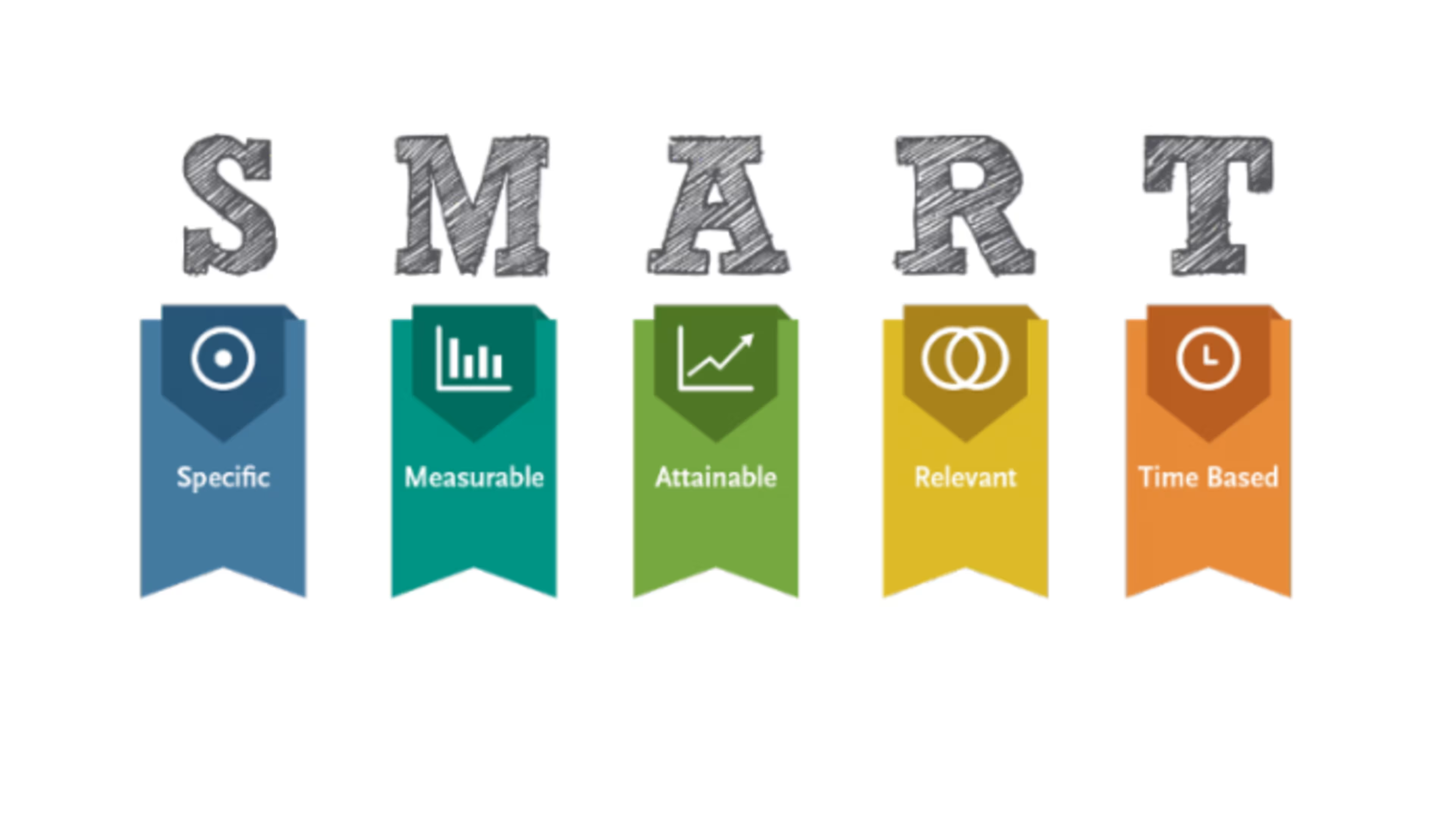Setting goals using Work Breakdown Structure, a Gantt chart, or any other project planning methodology is a good practice. The team can focus on these goals and make decisions based on them. That said, you should avoid unclear goals and objectives as they can easily turn project planning from a structured and well-organized process to a chaotic list of goals and milestones you cannot control.
Compare two goals:
Increase traffic.
The organic traffic of the site must be 1,500 visitors per day.

One is clear and measurable, one isn’t.
That is why SMART goals appear on the project planning horizon. A product manager usually formulates sprint goals in anticipation of goal and goal-detail sharing. SMART goals keep everyone focused and on the same page.
Why?
SMART provides a structure for goals and objectives. They track task implementation and, as a result, improve team efficiency.
So what are these SMART goals that can potentially solve so many problems in project planning? There are several criteria for that purpose that form SMART goals:

Specific Goals
Have precise goals.
Meet Murphy's Law, which claims that when something might go wrong, it will.
In the case of project planning and goal setting, consider this statement: "If there are several ways to understand the task, then someone will understand it improperly."
While setting goals, you should make them as accurate and specific as possible to avoid misinterpretation. Writing goals on paper or (even better) in an easily-accessible electronic format is also good practice. Fortunately, there are many types of project management software available to help achieve this end.
Examples of Goals:
Incorrect Goal: Make a cross-browser layout of the www.site.com
Correct Goal: www.site.com must be equally displayed in browsers IE6 +, Opera 6+, and Firefox 2+
Incorrect Goal: Make a valid layout of the www.site.com
Correct Goal: www.site.com must completely pass check validators w3c.org (http://www.w3.org/QA/Tools)
Agree on goal meanings instead of details.
You do not need to go into every minute detail of every goal. You just have to agree on each goal’s meaning. It is important that the team and the product owner understand each backlog element in an equal way.
Measurable Goals
Measure your achievements.
Measurable goals bring several benefits.
First, if there is a numerical measure of achievement, you know exactly at what stage of work you are and how much is left to do.
Second, you know exactly how much you have done. Sometimes, it is useful reflect on achievements to boost morale.
Finally, at the end of the workday, you and your teammates will be able to calculate by what percentage you achieved your target.
Examples of Goals:
Incorrect Goal: Increase traffic on the site.
Correct Goal: The traffic on the site must be 2,000 visitors per day.
Incorrect Goal: Make every visitor to buy more.
Correct Goal: Increase the sum of an average check by 10%.
The presence of metrics are important, and not only for formulation of backlog elements; they also allow the project manager to assess the size of the goal element. Although latest trends abandon numerical estimates in goal setting, it is impossible to make the process of project planning sufficiently accurate without them.
Form implementation intentions instead of goal intentions.
When setting project planning goals, project managers usually create succinct goals. Yet sometimes they fail because of changing requirements and situational cues.
Compare Goals:
Goal Intention: The feature must be released by May 20.
Implementation Intention: If the feature is still under development on May 5, an extra developer should be invited to the project.
With the focus on implementation intentions strategy, you can specify how a person should behave by predefining if-then situations. In this case, risk management is already taken care of, and there is a clear path to respond to negative events.
Attainable Goals
Set goals in accordance to your team members’ strengths.
Each person has a unique set of knowledge and skills, so it is necessary to select the appropriate goals for individual people. Referencing the skills and knowledge of the person, goals can be categorized:
Unreachable: The goals are unrealistic.
Elusive: The goals are unclear.
First of all, you should assign difficult or complicated goals to experienced and ambitious employees. The harder the goal, the greater the sense of achievement.
Good goals look like this:
Achievable: These goals correspond to the knowledge and skill level of the performer. For example, to draw the layout design of the approved site outline and brief in one day. Such tasks are necessary for respite between more difficult tasks and to develop self-confidence.
Easily accessible: These goals do not correspond to the competence of the employee. Reaching them does not give any sense of satisfaction for an employee. For example, to draw the button for a form in the specified style in a day. It is desirable to entrust such goals only to new employees to integrate them into the team.
The general conclusion is that it is necessary to alternate accessible and elusive goals. Using agile methodologies, when a team evaluates backlog items, such alternation is obtained in a natural way.
Set Learning Goals Instead of Performance Goals.
Most project managers measure goal achievements by learning metrics, but not performance metrics. The difference is that performance goals focus on the final result. In contrast, learning goals focus on the process itself and answer the question, “How can I reach this goal?”
Why is it important to focus on learning goals?
Surprisingly, learning goals are more likely to be achieved. Usually, when people face performance goals (these goals answer the questions like, “Can I outperform others?”), they focus on the end result and have a strong apprehension of failure. Doing so decreases their motivation and stops them from completing goals collaboratively.
With learning goals, people are able to devote their cognitive resources to a second task with minimal impact on performance.
Relevant Goals
Keep goals inspiring for the team.
The relevance of goals should be considered from two sides: goal relevance for the performer and for the company. Goal relevance (significance) for the team member is closely connected with his or her own set of personal motivations. For example, a research project can and should be given to an employee who enjoys learning new things, and wouldn’t be great for a programmer who would rather just code.
Keep goals relevant for the whole team.
Granted, when the team realizes that a goal is important, they’ll put in more effort when compared to "unimportant" goals.
And what can the team do if the goal is prioritized? Focus on efficiency. "Efficiency," in this case, can be measured by a deadline, the final product, and the cost of work.
Time-Based Goals
Set concrete goal deadlines from urgency to availability.
When discussing dates for goals, you should remember one more empirical law called “Parkinson's Law,” which states, “Any work expands so as to fill the time available for its completion.” If a task doesn’t have a deadline, immediate tasks displace it, and the chance that somebody ever gets around to it decreases. Thus, when setting any goal, always set a deadline.
The urgency of your goals is closely linked to goal-completion attainability. Let me show you why.
Examples of Goals:
Incorrect Goal: Make on the website the section "Contact Us" for a demonstration to the client by tomorrow.
Correct Goal: Make on the website the section "Contact Us" for demonstration to the client by noon 6/10/2016.
These deadline concepts integrate into Scrum. Iterations always have a fixed size and everyone knows precisely when will be a demonstration of sprint results.
Keep operational goals small while continuing to set high goals.
One of the SMART project planning tips is that operational goals and high-level goals should be clearly separated. Keep the low-level goals on which you are working small and achievable. This allows you to track the progress of the whole project and instantly make decisions based on the performance metrics.
But when setting ambitious goals, you assume that your colleagues have an ability to meet them, do not have any conflicting goals that can influence the result, and, finally, are moving in the same direction.
Interested in learning more about the project management best practices for innovation and co-creation? This video is for you.